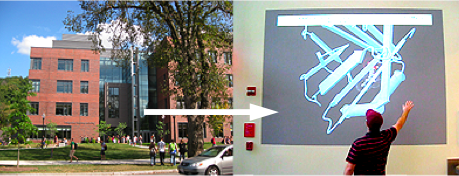Molecular Playground/HIV Protease Inhibitor
From Proteopedia
| Molecular Playground at the University of Massachusetts. MOVIE. |
Contents |
AIDS Before Protease Inhibitors
From 1981, when Acquired Immunodeficiency Syndrome (AIDS) was first recognized[1], until the mid-1990's, the life expectancy of a person after infection with Human Immunodeficiency Virus (HIV) was about 7-12 years[2], and even less for infants and children[3]. During this era, the available anti-HIV (anti-retroviral) drugs all worked on one target, the virus reverse transcriptase. The limited scope of these drugs made it easier for HIV to develop resistance to the drugs available at the time.
HIV Protease Inhibitors: A Breakthrough
|
In 1995, the US FDA approved the first HIV protease inhibitor drug, saquinivir[4], which was the first anti-retroviral drug with a completely different target. Hence it was deemed to be in a new second class of antiretroviral drugs. Combining an HIV protease inhibitor with two or more reverse transcriptase inhibitors was called highly active anti-retroviral therapy (HAART)[5]. HAART produced "an immediate and precipitous decline in HIV/AIDS mortality"[6]. Although young people infected with HIV may still have their lives shortened by 15-25 years, the life expectancy of HIV-positive people for whom optimal drug therapy is available is now 24 years or more[6].
Ritonavir
At right is shown the structure of Ritonavir® [7] (restore initial scene), an HIV protease inhibitor approved by the US FDA in 1996[4]. Ritonavir, the second HIV protease inhibitor to be approved by the FDA, improved the efficacy of the first, saquinivir, when the two were given together, by slowing the inactivation of saquinivir[8]
Molecular Playground Animation
|
|
You may rotate the molecule at any time during the animation.
There is also a LARGER version of this animation.
The Molecular Playground interactive projection in the Integrated Sciences Building at the University of Massachusetts, Amherst, USA, shows the molecular display that you see when you press the button above. This is only one of a series of modules that are shown. Instructions for authoring modules that display molecules in Molecular Playground are available.
Methods. The Play Animation button above runs a Jmol command script, which was authored by hand, and uploaded to Proteopedia. You can examine the script at Image:MP hivdrug.spt, which uses Image:MPSupportVersion01.spt (see Molecular Playground/Authoring). The atomic coordinate file (PDB file) displayed above (Image:Hivpi binding simulation.pdb.gz) contains 21 models, representing a simulation of the binding of Ritonavir to HIV protease. The simulation was done with MDL Sculpt starting with 1hxw, which remains as the 21st model.
See Also
- Flaps Morph for HIV Protease
- Structural Biology of HIV, an interactive Flash graphic of the virion with explanations of its components.
- MolviZ.Org for visualization of other important 3D structures.
- Morphs for an introduction to visualization of macromolecular conformational changes.
Additional Resources
For additional information, see: Human Immunodeficiency Virus
Notes
- ↑ History of AIDS up to 1986
- ↑ Lifetime Cost And Life Expectancy For Current HIV Care In The U.S. (2006).
- ↑ Care and treatment for HIV & AIDS orphans in Thailand: FAQ
- ↑ 4.0 4.1 HIV Protease Inihbitors at Wikipedia.
- ↑ HAART at Wikipedia.
- ↑ 6.0 6.1 HIV Life Expectancy Approaching Normal (2008).
- ↑ Saquinivir at Wikipedia.



